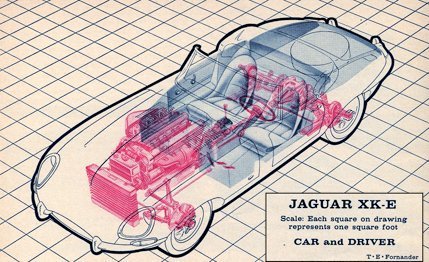The Case For All-Independence
Before going further, some consideration of the rear suspension is appropriate. Wheel motion follows the pattern of wishbone suspension rather than swing axles, the half-shafts actually serving as the upper wishbone, giving transverse location. Longitudinal location is assured by radius rods. A great deal of attention has been given to the geometry of this layout to eliminate any tendency to rear-end steering. The frame attachment points of the radius rods have been determined so that deflections are neutralized to the greatest possible extent. Four vertical coil springs enclosing telescopic shock absorbers provide enough softness to give a comfortable ride and a wheel travel short enough to retain basic geometry with ½° to 1° of negative camber, When we say that not only has this aim been accomplished but that bottoming can hardly be provoked either, readers will realize that the XK-E presents an important advance in independent rear suspension.
Well sprung for a sports car, a good combination of softness and stability, the XK-E shows some slight choppiness from small bumps at speeds up to about 50 mph. Over that, the feeling to occupants is one of almost uncanny smoothness and sure-footedness. Rutted dirt roads feel paved with virtually no jarring of the occupants, who are located close to midships.
|
|
Tire pressures would affect the ride to some extent. With 30 psi in the front tires and 35 psi in the rear ones, road shocks were felt in the entire car and the reactions in the steering wheel were amplified. A reversion to pressures recommended for normal driving (23 and 25, front and rear, for speeds up to 130) would provide enough softness in the tires to let them work as a springing medium, absorbing minor unevenness in the road surface at only slight loss of steering lightness.
The RS5 Dunlop tires tracked straight with silence on all but rough concrete surfaces, when considerable whine was apparent. On most corners they remained quiet but with high cornering forces they wailed loudly. Rain seemed no deterrent to high cruising speeds.
With all the power available, the risk of wheelspin would be considerable with previous Jaguar rear ends. The E-Type, as a further safeguard in this respect, has a Powr-Lok differential. The only wheelspin we experienced was provoked by high-rpm starts with ultra-rapid clutch release and, in fact, using worn tires. Even so, spectators confirm that both rear wheels were spinning and the only driver action required was minor corrections to counteract gentle snaking.
Weatherproofing
Not everything in the E can be soundly praised. Our car had chassis number 12 and had been used as a demonstrator so our remarks here may not be typical of the current production E-Type. The basic car is excellent, so fine in fact that even minor annoyances you’d accept in a lesser car seem magnified to disturbing proportions. The fit and finish of the panels is exemplary. We mentioned the seats and stated that this area of discomfort has apparently already been remedied. We expect as the E-Type evolves it will become one of the world’s truly great cars from any standpoint. However, we found rain leakage to be considerable over the top of the windshield, under the cowl and at the edge of the doors. The trunk also was afflicted with leaks which filtered water down into the spare tire well (an apt term) from which it could not escape due to the lack of drain holes. Ventilation with the top up was poor; the side windows needed to be opened almost half-way with the result that there was a blast of air striking the occupants in the car. With the top down, wind noise was very low at any speed and there was very little buffeting in the cockpit
View Photos
View Photos


Leave a Reply